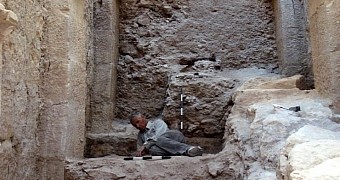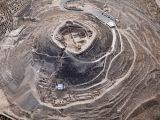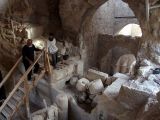Towards the end of last week, archaeologists in Israel announced the discovery of a spectacular entryway to King Herod the Great's palace not far from the city of Jerusalem. The corridor, a photo of which is included in the gallery below, opens into an even more impressive vestibule.
What's interesting is that, by the looks of it, this entryway was never used by King Herod the Great or his subjects. On the contrary, researchers say that Herod ordered workers to backfill it when he decided to turn the complex into a royal burial monument and memorial mound.
An entryway fit for a king
In a report documenting their find, researchers with The Hebrew University of Jerusalem's Institute of Archaeology detail that this entryway to King Herod the Great's palace that they excavated not too long ago comprises a corridor that is nothing short of impressive size-wise.
Thus, the corridor measures 20 meters (65 feet) in length and 6 meters (20 feet) in width. Besides, it stands a jaw-dropping 20 meters (65 feet) tall. Archaeologists add that the corridor withstood the test of time thanks to a complex system of arches especially designed to support it.
As mentioned, this corridor opens into a vestibule adorned with various frescoes. Together with the entryway, the vestibule was backfilled when the king decided that, rather than a palace, he had more use for a burial monument and a memorial mound, Phys Org explains.
Thus, it appears that, when realizing that he would soon get to shake hands with the Grim Reaper, King Herod the Great had workers build a massive stairway leading up to what was to be his final resting place over the corridor and the vestibule, archaeologists detail.
By the looks of it, a theater that was supposed to be part and parcel of the palace and several other structures were covered at well. All that remained standing was a mausoleum-like structure resting on top of a cone-shaped hill. This monument was to become Herod's burial place.
“The corridor was backfilled during the construction of the massive artificial hill at the end of Herod's reign,” researchers with The Hebrew University of Jerusalem's Institute of Archaeology explain in the report detailing their work.
“The upper section of a new monumental stairway stretching from the hill's base to its peak, constructed during the course of this building phase, appears to have been built over it,” the archaeologists who discovered this entryway go on to detail.
It is understood that, while exploring this corridor and the vestibule, researchers also found evidence of two revolts, of which one occurred between 66 and 71 AD and another between 132 and 135/6 AD. This evidence includes Jewish coinage, temporary structures, and tunnels created by rebels.
Why King Herod the Great got to work building this palace
Historical records show that King Herod the Great was born in 74 or 73 BC. He was appointed king of Judea by the Roman senate, and by the looks of it, he was ready and willing to do just about anything to keep his throne. Thus, his reputation is that of a madman.
Herod is said to have ordered workers to build a massive palace not far from Jerusalem as a way to celebrate his having defeated the Parthians in battle. The palace was to be erected on top of a hill and have a town next to it. However, things did not go quite as planned.
As explained by historians, the king eventually came to terms with the fact that he too would one day die, and had workers turn the hill that was supposed to serve as a home to his palace and its accompanying town into a burial complex.

 14 DAY TRIAL //
14 DAY TRIAL // 



